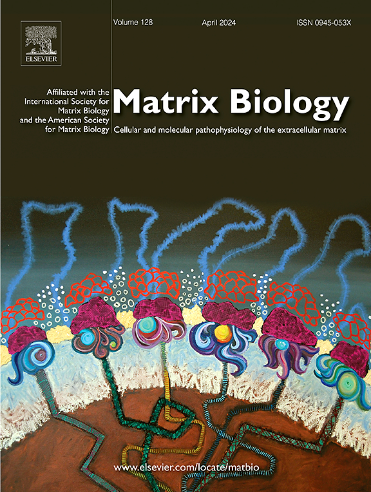Extracellular matrix architecture promotes immunosuppressive microenvironments in pancreatic cancer
IF 4.8
1区 生物学
Q1 BIOCHEMISTRY & MOLECULAR BIOLOGY
引用次数: 0
Abstract
Pancreatic ductal adenocarcinoma (PDA) is an aggressive cancer with poor clinical outcomes, due in part to altered fibrotic environments and striking immune dysfunction. Physical properties within tumors, such as aligned extracellular matrix (ECM) fiber architectures, are fundamental to cancer progression and outcome. However, the influence of ECM alignment on immune cell localization and function within tumors, particularly PDA, remains largely unexplored. Here, analysis of mouse and human PDA reveal an inextricable link between collagen architecture and the distribution of immunosuppressive macrophages in both early preinvasive disease and invasive carcinomas. In vitro characterization of primary macrophages demonstrates alignment alone is sufficient to induce elongation, polarization, and immunosuppressive activity, including suppression of CD8+ T cell proliferation and motility. Analysis reveals differential focal adhesion kinase (FAK) activity in aligned macrophages, while FAK inhibition (FAKi) disrupts the immunosuppressive phenotype that emerges from encountering ECM alignment. Furthermore, FAKi in vivo significantly reduces the correlation between elongated immunosuppressive macrophages and aligned collagen, further highlighting the opportunity for FAKi to target stromal immunity. Importantly, the correlation between aligned collagen and immunosuppressive macrophages is also observed in human chronic pancreatitis, a known PDA risk factor that has recently been shown to prime stromal ECM alignments for early dissemination, suggesting that precursor disease is also likely to create stromal memory conducive to early immunosuppression. Taken together, these results support a model in which collagen architecture supports early establishment and maintenance of an immunosuppressive microenvironments and defines a role for targeting stromal matrices to “reprogram” patient immunity.
细胞外基质结构促进胰腺癌的免疫抑制微环境。
胰腺导管腺癌(PDA)是一种侵袭性癌症,临床预后较差,部分原因是纤维化环境改变和显著的免疫功能障碍。肿瘤内部的物理特性,如排列的细胞外基质(ECM)纤维结构,是癌症进展和结果的基础。然而,ECM排列对肿瘤内免疫细胞定位和功能的影响,特别是PDA,在很大程度上仍未被探索。本研究对小鼠和人PDA的分析显示,在早期侵袭前疾病和侵袭性癌中,胶原结构和免疫抑制巨噬细胞分布之间存在着不可分割的联系。原代巨噬细胞的体外表征表明,单靠排列就足以诱导伸长、极化和免疫抑制活性,包括抑制CD8+ T细胞的增殖和运动。分析显示,在排列的巨噬细胞中,局灶黏附激酶(FAK)活性存在差异,而FAK抑制(FAKi)破坏了遇到ECM排列时出现的免疫抑制表型。此外,在体内,FAKi显著降低了细长的免疫抑制巨噬细胞和排列的胶原之间的相关性,进一步强调了FAKi靶向基质免疫的机会。重要的是,排列的胶原蛋白和免疫抑制巨噬细胞之间的相关性也在人类慢性胰腺炎中被观察到,这是一个已知的PDA危险因素,最近被证明是基质ECM排列早期传播的主要因素,这表明前体疾病也可能产生有利于早期免疫抑制的基质记忆。综上所述,这些结果支持了一个模型,其中胶原结构支持免疫抑制微环境的早期建立和维持,并定义了靶向基质基质“重编程”患者免疫的作用。
本文章由计算机程序翻译,如有差异,请以英文原文为准。
求助全文
约1分钟内获得全文
求助全文
来源期刊

Matrix Biology
生物-生化与分子生物学
CiteScore
11.40
自引率
4.30%
发文量
77
审稿时长
45 days
期刊介绍:
Matrix Biology (established in 1980 as Collagen and Related Research) is a cutting-edge journal that is devoted to publishing the latest results in matrix biology research. We welcome articles that reside at the nexus of understanding the cellular and molecular pathophysiology of the extracellular matrix. Matrix Biology focusses on solving elusive questions, opening new avenues of thought and discovery, and challenging longstanding biological paradigms.
 求助内容:
求助内容: 应助结果提醒方式:
应助结果提醒方式:


